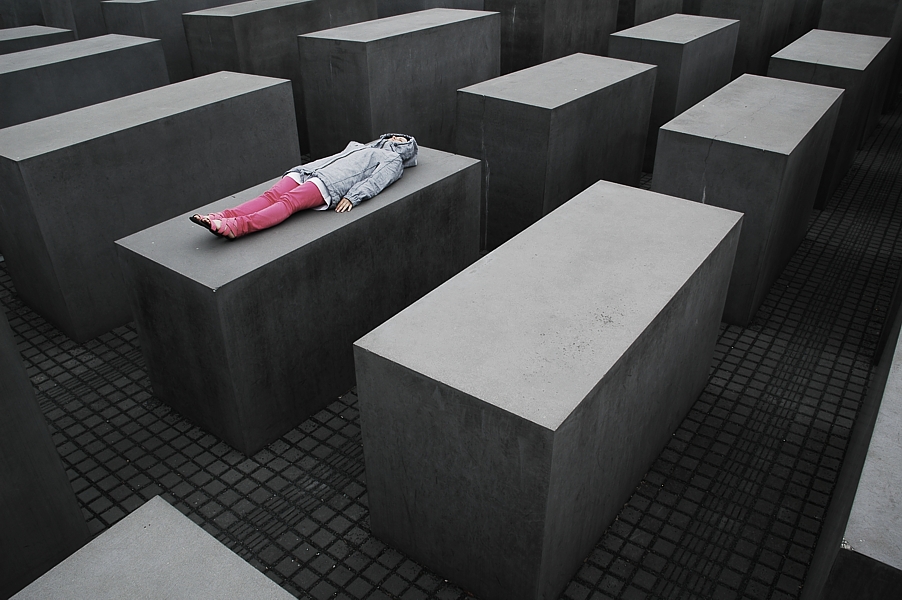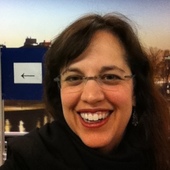Essay by Jill Bronfman
What If There Were a Magic Door?

It’s hard to get through any street in Berlin without tripping over a brass plaque that memorializes some poor soul who was born, deported, and murdered right on that spot. Then there are the statues and the museum exhibits and the ruins and the timelines and the bullet holes in the walls of not just synagogues but also museums and grand old houses, what few there are left.
I set off for Berlin a few years ago with my friend K, determined not to see the Holocaust. I’m Jewish and have always lived in the United States. K was born in Germany and lived there her first eighteen years before going to college in the States. As if to prove she is still German, she’s a psychologist and plays the violin. On this trip, K was open to anything, but I only wanted to see the happier times before the war, when Berlin was more like the Broadway show Cabaret. She isn’t Jewish. She didn’t understand, at first, why I needed to look away.
Though I’d been to the Holocaust museums in Washington, D.C., and in Israel, I didn’t have any desire to keep reminding myself of the horrors. I planned to visit the Weimar Germany Berlin, the fabled Germany between the wars of dance and music and gluttony. I’d wobble on cobblestones and wear dirndls or at least flamboyant scarves.
But given the inevitable grimness, I agreed on our last morning in Berlin to a brisk walk through the Holocaust Memorial near the Reichstag. The walk-through sculpture is striking and strange, with gray granite blocks lined up as far as you can see. Many people have said this field of blocks looks like tombstones. Hey, I said to K, look how they start so small and get bigger, like if you keep walking, you’d hardly realize how they’ve grown until they’re over your head.
This lasted a good four and a half seconds, and I was out of there. I walked faster and faster, until the blocks got a bit lower, and I could see the sky again.
That’s when we saw a school group, a bunch of teenagers with a teacher lecturing in German to them. Some sat and listened, and some played hopscotch on the top of the blocks, leaping from one to the other up and down the rows. While K listened to the German, I looked around. And there it was. The most absurd thing in all of Berlin, and I’d found it, and no one else had.
I should mention that this was my first trip to Germany. When I told various Jewish friends and family members I intended to go, they reacted with a range of emotions, from disgust to disinterest. At least two people said they would never set foot in Germany because there was blood under the sidewalks. Meanwhile, another German friend asked me why Jewish people didn’t want to visit Germany—was it fear or just a fervent desire not to throw money in the direction of so much devastation? The latter, I responded, almost sure. It would be safe there now, I thought.
At the Holocaust Memorial in Berlin, however, even though I was under an open sky and free to go whenever I wanted, I felt an overwhelming urge to get the hell out.
And sure enough, there was an escape route.
You’re thinking I mean a metaphorical escape route. That I could go any time, leave whenever, take a plane, train, or automobile. I could just walk away, unlike any Jew in the late 1930s, post-Kristallnacht. No. I saw an actual escape route. Around one corner of the endless blocks, there was an emergency exit, right in the center of the memorial.
Seriously, I said to K, look at this. There’s a clearly marked emergency exit in the middle of this thing. I walked down the steps and placed my hand on the cool steel door. I made her take a picture of me pretending to push the door open and escape. She said, stop smiling, act scared. You look too happy to be escaping the Holocaust. I pulled down the edges of my mouth, but I was nervously giggling. Dorothy, I thought, maybe you just had to click your heels together. Maybe you could just push open a magic door in 1942 and leave your fate behind.
I didn’t open the door. It didn’t have one of those emergency warnings saying an alarm would sound or any threat at all about the consequences of venturing inside or out. But I’ve read too much Philip K. Dick. For a second, I imagined pushing open the door and sliding through. I’d slip into 1942 and be running for my life. Or not running at all. I’d be hiding behind a bookcase in an upstairs flat and planning my escape for real.

Publishing Information
- “The Memorial to the Murdered Jews of Europe (Information Centre),” MuseumsPortal Berlin.
Art Information
- "Eisenman's Rectangular Prisms" and photo of memorial emergency exit © Lisa Shahno; Creative Commons license.
 Jill Bronfman is a lawyer, professor, activist, volunteer, and parent who spends a lot of time reimagining history and worrying about how history might repeat itself.
Jill Bronfman is a lawyer, professor, activist, volunteer, and parent who spends a lot of time reimagining history and worrying about how history might repeat itself.
